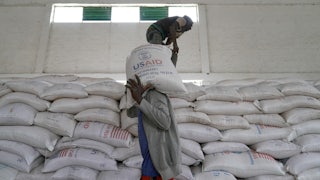To an ordinary person, there’s a lot that doesn’t make sense about Harrington v. Purdue Pharma, a major case in which the Supreme Court will hear arguments this term. It’s a bankruptcy case. But it’s not about people who are in bankruptcy. In fact, it’s about giving those people who aren’t in bankruptcy even more legal protection than they could get if they really were in bankruptcy. And it’s about whether those people can buy their way out of liability for any wrongdoing they’ve done—without a trial and without the consent of the people they’ve harmed.
All of this in a bankruptcy case. Got that?
The backstory is easier to get. It’s a story of how the Sackler family built its vast wealth from its company that aggressively sold opioids and hid their addictive nature—and in the process, fueled an epidemic that has taken hundreds of thousands of lives.
Purdue was first convicted of drug-marketing crimes in 2007. But in the wake of that plea, the Sackler-run company only intensified its sales push (including paying kickbacks to doctors and others to increase opioid prescriptions). At the same time, as a federal district judge later described it, the Sackler family members involved with running Purdue were well aware of their personal liability. “Concerned about how their personal financial situation might be affected,” the judge wrote, “the family began … withdrawing money from Purdue almost as soon as the ink was dry on the 2007 papers.”
By 2019, Purdue and the Sacklers were facing a flood of lawsuits by opioid survivors and others who got caught in the epidemic. By then, the Sackler family members had siphoned off 75 percent of Purdue’s profits for themselves. Purdue’s board later put the firm in bankruptcy.*
The Sackler family members used Purdue’s bankruptcy to cut a deal with some of those victims and survivors and others—a deal the Sacklers couldn’t get anywhere else. The deal, which was approved by 95 percent of those voting (though fewer than 20 percent of those who could vote did), lets the Sacklers pay up to $6 billion over 18 years in exchange for a broad release that, if it stands, will forever shield them and hundreds of others from facing people in court like Ellen Isaacs. Her son Ryan became addicted to opioids after a doctor prescribed OxyContin when he fell off a bridge and hurt his back. He died from overdosing on opioids in 2018.
There’s no way to measure whether and for how much the Sackler family members who ran Purdue should truly be liable, because they’ve never stood trial for their actions at Purdue. In all this time, the Justice Department has not charged any of the Sackler family members with a crime. Unless that changes, it leaves any notion of justice to be had in a bankruptcy court. Or with the Supreme Court.
The Supreme Court took this case to answer what a federal judge called the “great unsettled question” in the Purdue case: Does the bankruptcy code allow for a bankruptcy like Purdue’s to include protection (in the form of a liability release) for people who aren’t in bankruptcy, like the Sacklers? Sackler family members said they would not contribute money to the bankruptcy without such immunity.
Purdue’s bankruptcy judge approved a broadly worded release that covers hundreds of Sackler family members, their descendants, and others connected to Purdue and other entities. The release protects the Sacklers and the others from claims based on fraud and “willful misconduct”—something the bankruptcy code explicitly bars for people who are in bankruptcy.
A federal district court judge rejected Purdue’s plan, ruling that the bankruptcy code does not authorize releases like the one the Sacklers demanded. The Second Circuit Court of Appeals disagreed and upheld the plan. The Second Circuit panel reasoned, in part, that because the bankruptcy code does not explicitly prohibit releases, they are legal.
The public’s bankruptcy watchdog for New York, William Harrington, appealed to the Supreme Court, and the solicitor general of the United States is representing him.
Upholding the Sackler release “would leave in place a roadmap for wealthy corporations and individuals to misuse the bankruptcy system to avoid mass tort liability,” the solicitor general wrote to the Supreme Court. The justices agreed to hear the case in December—and to pause Purdue’s plan in the meantime.
In sometimes stark language, a number of law professors argue in amicus briefs that the rationale invoked by the Second Circuit panel is being used to protect people outside bankruptcy and to strip survivors and others of their fundamental right to sue and be heard, forcing some of them to take a deal they don’t agree to. They brand the Sackler release as “abusive,” a “moral hazard,” and a “descent into lawlessness” in Chapter 11.
A group of Canadian municipalities and First Nations protest the Sackler release—which voters did not get to approve separately—as barring “anyone, anywhere, anytime, from filing an opioid-related claim against thousands of individuals and entities—including generations of Sackler family members born and unborn, along with officers, directors, trustees and others for Purdue and its related entities—for their roles in directing, assisting, and facilitating Purdue’s misconduct.”
For its part, Purdue argues the Second Circuit got it right and that challenging the plan would only hurt the victims and survivors. Purdue said it had “nearly universal support”—among those who voted—for a plan it calls “fair and equitable.”
Lawyers representing 60,000 victims agreed and asked the Supreme Court not to delay what they called a “remarkable settlement.” The settlement provides up to $750 million for individual survivors; most of the Sackler payment is slated to go toward opioid abatement measures.
The $750 million will have to go toward legal fees and other costs before going to survivors, however. And some survivors, including Ellen Isaacs, are now learning of the stringent requirements for documenting a family member’s OxyContin use in order to be paid.
A lot of bankruptcy experts think the court will reject these releases outright, based on the lack of explicit statutory authority and the constitutional problems with due process, separation of powers, and the right to a jury trial. Others say it could get more complicated. Purdue’s arguments that most of those voting approved the plan could hold sway, as could its arguments (backed by business groups like the U.S. Chamber of Commerce) that these releases are necessary in complex cases.
If Purdue wins, and the Sackler family members get to keep their release as is, expect bankruptcy courts to take over more and more mass tort cases. Critics say we can also expect owners of companies who want to hide massive wrongdoing to use Chapter 11 as an escape hatch. That could leave victims and survivors of that wrongdoing in this bizarre legal purgatory: overseen by a bankruptcy judge who does not have the power to rule on their claims against the wrongdoers but who has the power to prevent them from ever being heard.
* This article has been updated to clarify the chain of command prior to the bankruptcy filing.










